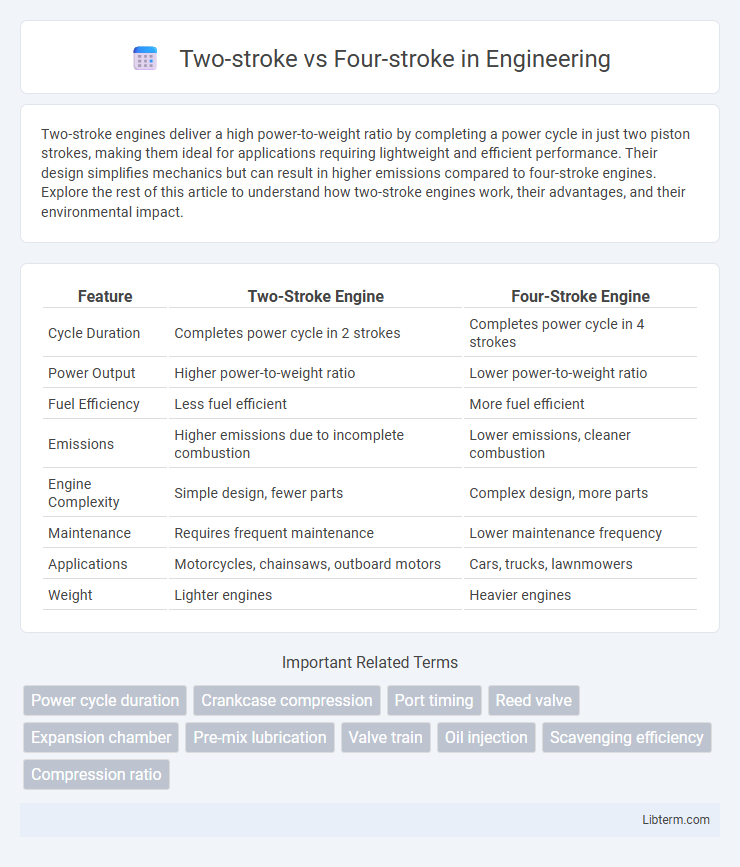Two-stroke engines deliver a high power-to-weight ratio by completing a power cycle in just two piston strokes, making them ideal for applications requiring lightweight and efficient performance. Their design simplifies mechanics but can result in higher emissions compared to four-stroke engines. Explore the rest of this article to understand how two-stroke engines work, their advantages, and their environmental impact.
Table of Comparison
| Feature | Two-Stroke Engine | Four-Stroke Engine |
|---|---|---|
| Cycle Duration | Completes power cycle in 2 strokes | Completes power cycle in 4 strokes |
| Power Output | Higher power-to-weight ratio | Lower power-to-weight ratio |
| Fuel Efficiency | Less fuel efficient | More fuel efficient |
| Emissions | Higher emissions due to incomplete combustion | Lower emissions, cleaner combustion |
| Engine Complexity | Simple design, fewer parts | Complex design, more parts |
| Maintenance | Requires frequent maintenance | Lower maintenance frequency |
| Applications | Motorcycles, chainsaws, outboard motors | Cars, trucks, lawnmowers |
| Weight | Lighter engines | Heavier engines |
Introduction: Two-Stroke vs Four-Stroke Engines
Two-stroke engines complete a power cycle in two piston strokes, combining intake and compression, as well as combustion and exhaust, making them lightweight and powerful for their size. Four-stroke engines operate through four separate piston strokes--intake, compression, power, and exhaust--resulting in better fuel efficiency and lower emissions. The distinct mechanical differences influence engine performance, maintenance, and application suitability in motorcycles, lawn equipment, and marine vehicles.
Basic Working Principles
Two-stroke engines complete a power cycle in two movements of the piston, combining intake and compression in the first stroke, and combustion and exhaust in the second, enabling a higher power-to-weight ratio. Four-stroke engines separate these processes into four distinct strokes: intake, compression, power, and exhaust, allowing for better fuel efficiency and cleaner emissions. The two-stroke design typically offers simplicity and lighter weight, while the four-stroke engine provides increased durability and smoother operation.
Key Differences in Engine Design
Two-stroke engines complete a power cycle in two piston strokes, combining intake and compression with combustion and exhaust, resulting in a simpler design with fewer moving parts than four-stroke engines. Four-stroke engines separate these processes into four distinct strokes--intake, compression, power, and exhaust--allowing for better fuel efficiency, lower emissions, and smoother operation. The two-stroke design enables higher power-to-weight ratios, while four-stroke engines emphasize longevity and environmental compliance through more complex valve mechanisms.
Power Output and Performance
Two-stroke engines produce power once every revolution, delivering higher power output and quicker acceleration compared to four-stroke engines, which generate power every two revolutions. This leads to a greater power-to-weight ratio in two-stroke motors, making them ideal for applications requiring rapid bursts of speed and high performance, such as motocross and chainsaws. However, four-stroke engines provide more consistent power delivery, better fuel efficiency, and improved emissions control, favoring reliability and sustained performance in motorcycles and automobiles.
Fuel Efficiency Comparison
Two-stroke engines typically consume more fuel than four-stroke engines due to their design, which allows for fuel and air mixture to be expelled before full combustion, resulting in lower fuel efficiency. Four-stroke engines achieve better fuel efficiency by completing the intake, compression, power, and exhaust strokes separately, optimizing fuel combustion and reducing wastage. Consequently, four-stroke engines are preferred in applications where fuel economy is a critical factor.
Maintenance Requirements
Two-stroke engines require more frequent maintenance due to their simpler design and higher operating speeds, including regular spark plug replacement and frequent oil changes to prevent buildup and wear. Four-stroke engines have a more complex valve system, necessitating periodic valve adjustments and less frequent but more involved oil and filter changes, resulting in a longer maintenance interval overall. Proper maintenance of both engine types significantly impacts performance efficiency and engine lifespan.
Emissions and Environmental Impact
Two-stroke engines emit higher levels of unburned hydrocarbons and particulate matter due to incomplete combustion and oil mixed with fuel, significantly contributing to air pollution. Four-stroke engines feature separate lubrication systems and more efficient combustion processes, resulting in lower emissions of carbon monoxide, hydrocarbons, and nitrogen oxides, which lessens their environmental footprint. Regulatory agencies often favor four-stroke engines for stricter emissions standards and improving air quality in urban areas.
Cost Considerations
Two-stroke engines generally have lower upfront costs due to their simpler design and fewer moving parts, making them more affordable for entry-level applications. Four-stroke engines, while typically more expensive initially, offer better fuel efficiency and longer engine lifespan, reducing long-term maintenance and fuel expenses. Considering total cost of ownership, four-stroke engines often provide more economic value despite higher initial investment.
Typical Applications and Use Cases
Two-stroke engines dominate in applications requiring lightweight and high power-to-weight ratios, such as chainsaws, dirt bikes, and outboard motors, due to their simpler design and faster power delivery. Four-stroke engines excel in automotive vehicles, lawn mowers, and generators, where fuel efficiency, emission control, and smoother operation are critical. The choice between two-stroke and four-stroke engines depends on balancing performance demands with environmental regulations and maintenance considerations.
Choosing the Right Engine: Factors to Consider
Choosing between two-stroke and four-stroke engines depends on factors like fuel efficiency, power output, and maintenance requirements. Two-stroke engines offer higher power-to-weight ratios and simpler designs, ideal for lightweight applications but consume more fuel and emit more pollutants. Four-stroke engines provide better fuel economy, lower emissions, and longer lifespans, making them suitable for daily use and environmentally conscious consumers.
Two-stroke Infographic

 libterm.com
libterm.com